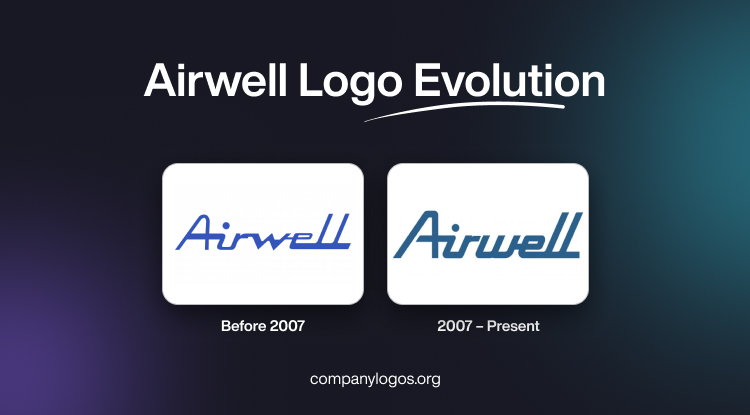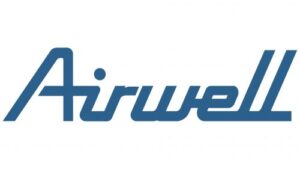
Airwell is a French company engaged in the manufacture of air conditioning solutions since 1947. Originally called Établissements Guillemin, the company has been a pioneer of heating and cooling technology. In fact, it has developed the first window-mounted air conditioner and the first split-system air conditioner in Europe. Over the decades, the company has expanded its product range and made a strong presence in markets around the world. Throughout the existence of the company, its logo has served as its striking visual identity and a symbol of excellence, adaptability, and a forward-thinking approach.
Over the years, the Airwell logo has undergone a remarkable evolution. It reflects the growth of the company and the transformation in the HVAC (Heating, Ventilation, and Air Conditioning) industry. This article delves into the evolution of the Airwell logo and traces its roots from the establishment of the company to its acquisition by the Swiss group CIAT in 2013.
The Genesis of the Airwell Logo (Before 2007)
The Airwell logo has undergone two iterations in its history. And each iteration reflects the times and the evolving identity of the brand. Before 2007, the logo showed a stylized representation of an air vent or grille. It was a symbol that the company focused on air conditioning and ventilation systems.
The design of the logo before 2007 had clean lines and a minimalist approach. It conveyed a sense of simplicity and efficiency. The symbolism behind the logo showed the company’s focus on developing innovative solutions based on attributes like comfort, energy efficiency, and reliability.

(2007 – Present)
In 2007, Airwell underwent a comprehensive rebranding exercise. This led to the redesign of its iconic logo. The updated logo featured a more modern and dynamic design. It had a stylized ‘A’ formed by two overlapping curves, which represented the seamless integration of the heating and cooling solutions.
The new logo has a bold and contemporary appearance that reflects Airwell’s efforts to stay ahead of the curve by embracing cutting-edge technologies. Moreover, the overlapping curves show the holistic approach of the company to HVAC solutions. They seamlessly blend the heating and cooling systems to provide optimal comfort and energy efficiency.
Since the present logo was introduced in 2007, it has become a recognizable symbol in the HVAC industry. It appears on the products, marketing materials, and corporate communications of the company. Besides, its clean and sophisticated design continues to resonate with the target audience of the company and conveys a sense of innovation, quality, and reliability.

The Elements of the Airwell Logo
Font
The custom italicised wordmark of the Airwell logo has a distinct typeface. The curved strokes of the typeface evoke a sense of warmth and familiarity. At the same time, the sharp, angular lines and cuts of its characters give it a touch of modernity and strength. This unique choice of font strikes a delicate balance between the heritage of the brand and its forward-thinking approach. It draws inspiration from classic typefaces like Continental Railway and incorporates elements that look sleek and stylish in Cabriolet.
Colour
The Airwell visual identity has a serene, medium-blue colour palette that exudes a sense of stability, reliability, and trustworthiness. The calming palette conveys the fundamental values and commitment of the company to delivering dependable solutions. Further, the choice of blue reinforces the position of Airwell as a steadfast and trusted brand, which customers can rely on for their heating, ventilation, and air conditioning needs.
The History of Airwell
In the aftermath of World War II, Jean-Pierre Guillemin established Établissements Guillemin in Paris, which would go on to become the Airwell brand. Initially, the company was focused on developing heating products only. In fact, the early years of the company went into providing efficient and reliable solutions to meet the growing demand for residential and commercial heating systems in the post-war rebuilding efforts.
As the company grew and the markets evolved, Airwell recognised the need to expand its product range beyond heating solutions. And after years of its founding, Airwell diversified its product range. This had a comprehensive array of HVAC solutions, including air conditioning units. This strategic move put the company as the provider of a one stop solution for all heating, ventilation, and air conditioning needs.
In 1950, Airwell introduced its pioneering window-mounted air conditioner, which was a significant milestone in its history. This innovative product was a game-changer in the industry, for it offered a compact and convenient cooling solution for residential and small commercial spaces. The success of this product paved the way for the continued growth of Airwell. In fact, it established the company’s position as a leader in the HVAC market.
In the 1970s, Airwell achieved another remarkable feat by launching the first European split-system air conditioner. This avant-garde product revolutionized the way cooling systems were designed and installed. It offered greater flexibility, efficiency, and aesthetic appeal compared to traditional window units.
The introduction of the split-system air conditioner marked a significant point in the history of Airwell. It cemented its reputation as an innovative and forward-thinking company. This achievement elevated Airwell’s position in the European market and paved the way for its global expansion and continued success in the years to come.
Interesting Facts About Airwell
- Airwell was founded in 1947 with the innovative idea of bringing air conditioning solutions from the United States to Europe, where such technology did not yet exist.
- Airwell was the first European manufacturer to produce wall split air conditioning systems. These involved splitting the core window unit into two parts.
- It was also the first in Europe to design wall-mounted units with integrated remote controls, advanced tangential fans for quieter operation, and energy-efficient rotary compressors.
- Airwell has a presence in over 80 countries. It served both European and African markets initially, and later expanded to the Middle East and Latin America.
- The company has a strong focus on energy efficiency, solar integration, and eco-responsibility. Its mission is to optimize energy consumption, promote solar energy, and reduce environmental impact through innovative solutions.
- Airwell offers over 600 products, which include air conditioners, heat pumps, and hybrid systems.
- Airwell has developed connected home solutions such as the “Hybrid House” and the AirHome smartphone application. These allow users to manage their home climate and energy consumption remotely.
- Airwell is recognized as France’s leading designer of heat pumps and was a major European manufacturer in the 1970s. It continues to be a reference in climate and thermal engineering.
- The company is a member of the Communauté du Coq Vert, an organisation dedicated to ecological transition. It actively works to reduce the carbon footprint of its products and operations.
- Airwell celebrated its 75th anniversary in 2022, which marked decades of continuous innovation and adaptation to market trends.
- Airwell emphasizes well-being, comfort, and acoustic quality in its products. It aims to enhance the living environment while maintaining energy efficiency and aesthetic appeal.
Finally
The evolution of the Airwell logo is a reflection of the company’s journey over the years. It tells the journey of the company from its beginnings as a heating equipment manufacturer to its current status as a global leader in the HVAC industry. The transformation of the logo has been a visual representation of Airwell’s ability to adapt and innovate.
At the same time, it signalled the core values of the company, namely, quality, efficiency, and customer satisfaction. The logo of Airwell remains a powerful symbol of the excellence of the company and its steadfast pursuit of innovative solutions to enhance comfort and energy efficiency.